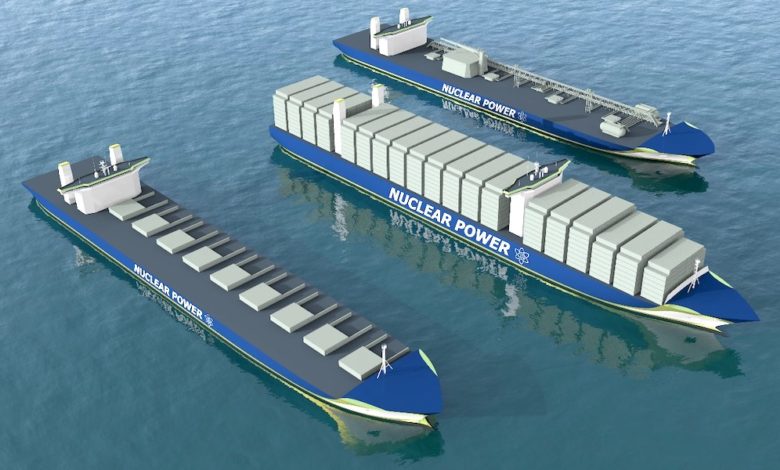Nuclear’s place in the future fuels debate

Hal Malone, principal of Sea/Switch Partners, on the potential and hurdles for a nuclear-powered shipping future.
In early July, shipping’s global regulator, the UN’s International Maritime Organization (IMO) reached an agreement targeting net-zero emissions by 2050. With ships moving approximately 90% of international trade and producing roughly 3% of global carbon emissions, there is general agreement that substantially reducing shipping’s emissions is critical to limiting further global warming. However, the IMO’s announced agreement is non-binding and lacks a specific roadmap, as well as economic incentives to achieve its goals. Could a transition to nuclear-powered commercial ships be the answer?
Today’s nuclear technologies are not the images most of us have etched in our memories. And, they promise all the right things: zero carbon emissions, uninterrupted power generation, potential to be modular and adaptable to a wide range of applications. But, a nuclear transition for industrial shipping faces several immense challenges: technology commercialisation, development of new financial models and, likely the most difficult, a resetting of public perceptions.
The nuclear power solutions currently being explored for industrial ships are generally based on molten salt reactors, a technology that was developed over 50 years ago. Supporters of molten salt reactors believe they offer substantial benefits relative to nuclear-powered military vessels technology. Most significantly, molten salt reactors do not require solid fuel, which eliminates the need to refuel them during their expected useful life at sea, as well as the requirement to handle or dispose of waste other than at vessel recycling. There are several multinational groups with experience in nuclear projects working to commercialise these proven concepts, which include Japanese and Korean shipbuilders leveraging their parent company’s industrial roots to pursue shipping opportunities.
Another barrier to nuclear-powered vessels is commercial shipping’s well-established financial model. Most industrial ships are built and owned by shipowners and then employed by cargo movers on either a voyage or time charter basis. The shipowners typically finance, maintain and operate the ships, while the cargo movers generally pay the fuel costs as part of voyage freight or under time charters. However, much like the disruptive impact of solar and wind power on electricity generation, a shift to nuclear-powered vessels would require rethinking shipping’s financial relationships. Nuclear vessels would require substantially more upfront investment to construct, and potentially cost more to operate, but as noted would not require additional fuel during their expected useful lives and could travel at substantially higher speeds with zero emissions. Resetting the financial relationships between shipowners and cargo movers, particularly for an unproven technology, will necessitate substantial collaboration and compromise, including the potential requirement for regulatory incentives.
Lastly, but perhaps most significantly, public perception of nuclear power is quite negative. Rationally or irrationally given the newer technologies, the public fears nuclear-powered solutions for electricity generation and other uses. What will be needed to convince authorities to allow nuclear-powered ships to enter ports near population centres? How can fears of hijacking or other terrorist threats be allayed? Substantial public education effort will be required. And, this will be a major challenge in the era of social media with entrenched public perceptions and vested fossil fuel and other interests incentivised to oppose transition efforts.
So, while the challenges are not insignificant, nuclear-powered ships represent one of the few potentially viable paths to true carbon-free commercial shipping. Further, a prominent group of respected investors, government organisations and private conglomerates have put their weight into finding commercial pathways for the latest technologies. As a result, the IMO together with other industry regulators and governments should aggressively support further exploration of nuclear-powered solutions with investment and other initiatives. Shipowners and cargo movers should begin rethinking their financial models and exploring new partnerships to bring these technologies to reality. And an effort by all parties should be begun to educate the public about the potential benefits of a nuclear-powered shipping future.

Very good article. Just finished MEPC 80 meeting saw a very good presentation from Mikal Boe, representing World Nuclear Transport Institute (WNTI)- brought up similar points and made a very good case for the IMO taking a serious look at nuclear as it looks to decarbonize shipping.
Here’s the link to Mr Boe’s presentation at MEPC80.
https://www.youtube.com/watch?v=DdBGW0XrPyI
There is a related, but possibly equally efficient alternative: use molten salt power to produce ammonia (or hydrogen) and use that as a fuel. See this study. https://www.zerocarbonshipping.com/publications/e-ammonia-production-from-nuclear-power/ Companies like Copenhagen Atomics in the EU (UK Atomics in the UK), Flibe in the US, etc are at the forefront of this. See this article (ammonia for fertilizer, but of course, it can be used for fuel): https://www.neimagazine.com/news/newsdanish-companies-support-smr-use-for-ammonia-production-in-indonesia-10876912
Nuclear fuel has 4 million times more energy per kg than Green NH3 (ammonia), which has less than 50% of the energy content of IFO380. Using advanced nuclear, including MSRs to power green NH3 production is the most efficient and cost effective way to do it, but hardly more effective than the MSR itself. Copenhagen Atomics may be viable if they can raise money to build a machine, Flibe is never going to build anything.